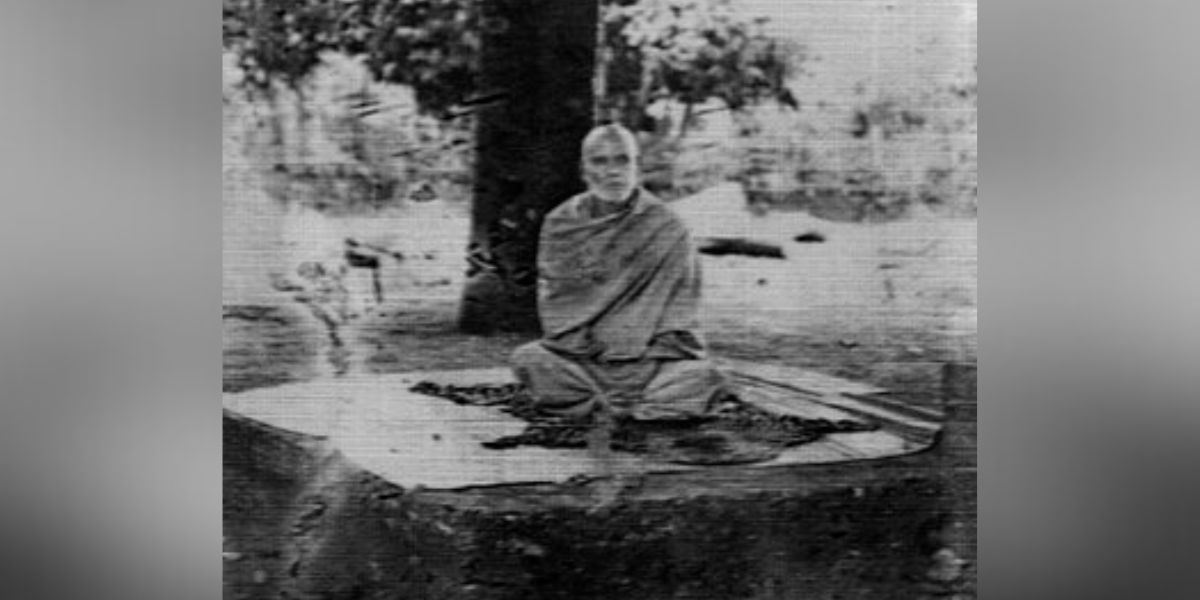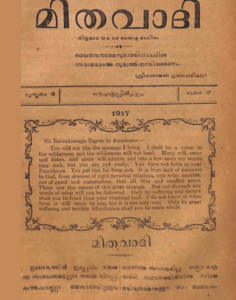The archive’s goal is to offer scholars, students, and the general public a systematic and credible resource for research on Narayana Guru’s profound impact on society.
Published Jan 28, 2025 | 4:45 PM ⚊ Updated Jan 28, 2025 | 4:45 PM

Sree Narayana Guru. (Creative Commons)
The date was 15 November 1922, and the place was Sivagiri in Kerala’s Thiruvananthapuram. A historic encounter was unfolding — a meeting of two titans, Sree Narayana Guru and Rabindranath Tagore.
Moved by the Guru’s spiritual brilliance, Tagore penned these unforgettable words in the visitor’s book: “During my travels worldwide, I have had the good fortune to come in contact with several saints and maharishis. But I have frankly to admit that I have never come across one who is spiritually greater than Swami Narayana Guru or a person who is at par with him in spiritual attainment.”
Such was the magnetic aura of Narayana Guru — a philosopher, spiritual leader, poet, educationist, and social revolutionary who shattered caste barriers with his timeless message: One caste, one religion, one God for mankind.
The meeting led to widespread recognition of the reform movement by Guru in the then-Kerala society, which was deeply divided along caste and communal lines.
Nearly a century after his passing, Guru’s life and legacy remain a profound source of inspiration. They are intertwined with the socio-political and cultural fabric of erstwhile Travancore and beyond.
Today, a slew of novel initiatives promises to delve deeper into his revolutionary spirit, unearthing his vast and enduring influence over society and its transformation.
Chief Minister Pinarayi Vijayan’s recent remarks at the inauguration of the 92nd Sivagiri Pilgrimage in Varkala have sparked intense debate, particularly his criticism of attempts to portray Guru as a proponent of Sanatana Dharma. A heated debate continues to rage over whether Guru was a proponent of Sanatana Dharma or a challenger to its orthodoxy.
However, an intriguing police intelligence report from his lifetime offers a dramatic perspective, claiming that Hinduism was “under threat” because of the Guru’s revolutionary teachings. Referring to his works, the report ominously warned that “Hinduism will no longer remain the same.”
This fascinating anecdote, along with rare documents and endangered literature on Narayana Guru, forms part of the Narayana Guru Digital Research Resource Platform (NGDRRP) — an ambitious project to digitise and preserve his legacy.
The initiative, a collaboration between the Indian Institute of Technology (IIT) Bombay, Sree Narayana Mandira Samity (SNMS), Mumbai, Sree Narayana Guru College of Commerce, Chembur (SNGCC), and Informatics Publishing Limited Bengaluru, aims to compile scattered and inaccessible materials into a systematic digital archive.
According to NGDRRP Consultant and Project Coordinator Dr Girija KP, the two-year project that began in May 2023 has already scanned 2,70,000 pages of materials, some of which have been released on the digital library platform JSTOR under the title “Narayana Guru and Twentieth Century Kerala“, with the help of the South Asia Open Archives.
These include 292 magazines such as Vivekodayam, Dharmam, Sahodaran, Mitavadi, Prabodhakan, Yuktivadi, and many others.
The project involves contributions from personal and institutional collections, including:
G Priyadarshanan’s Private Collection – Perettil, Varkala
Brahmavidyalayam Library – Shivagiri Mutt, Varkala
Institute of the Science of the Absolute – Varkala
Narayana Gurukula Library – Varkala
Dr Vinayakumar’s Collection – Kollam
Sree Narayana Public Library – Irinjalakkuda
Vasumithran’s Private Collection – Thalassery
Sree Jnanodaya Yogam SN Library – Jagannatha Temple, Thalassery
Mahakavi Kumaranasan Memorial Library – Kannur
“These sites were goldmines of rare souvenirs, books, and magazines,” said Dr Girija in an email to South First. “Although other libraries were visited, they couldn’t be covered within the project timeline.”
The concerned said that the materials free of copyright, along with those for which permissions have been secured, will be made publicly accessible by May 2025.
The archive’s goal is to offer scholars, students, and the general public a systematic and credible resource for research on Narayana Guru’s profound impact on society.
While Siby K George, Professor of Philosophy at IIT Bombay, acts as the principal investigator of NGDRRP, experts from Tata Institute of Social Sciences (TISS) Mumbai, SNGCC and Kerala Council of Historical Research, Thiruvananthapuram are associating as co-principal investigators.
In addition to that scores of interns and professionals in the field such as Professor J Devika, CDS Thiruvananthapuram, have also played a major role in materializing the NGDRRP.
According to Anish Damodaran of SNMS, the initiative NGDRRP is not intended to settle debates about whether Narayana Guru advocated for Sanathana Dharma but instead aims to make previously inaccessible materials widely available for researchers and admirers of the reformer.
“The project seeks to uncover and preserve literature that captures the Guru’s multifaceted personality and the socio-spiritual movement he inspired. Among the treasures being digitised, there are old magazines published during his time, providing invaluable insights into the historical and cultural context of his teachings and activism,” Anish told South First.

A 1917 issue of Mithavadi magazine, digitised and made available by South Asia Open Archives.
He added, “While the writings of Sree Narayana Guru himself are widely available today, the extensive wealth of literature surrounding the Sree Narayana Movement remains largely unexplored.”
He pointed out that many of these works are in private collections or housed in public and private libraries, often in fragile conditions.
“The dilapidating state of these collections and the risk of their permanent loss motivated us to take action,” said Anish.
Key activities of the project include gathering materials from diverse sources, sorting and classifying them into a systematic framework, and digitising texts for long-term preservation.
Despite challenges such as accessing rare materials, verifying their authenticity, and establishing infrastructure for digitisation, the initiative has made notable progress.
“The team has already acquired a substantial volume of literature and is finalising the digitisation process. The SNMS has mobilised ₹42 lakh to fund the two-year project, underscoring its commitment to ensuring this heritage is preserved for future generations. We are creating a resource that can help scholars and proponents of the Guru appreciate the complexity and richness of the movement’s legacy,” added Anish.
In another groundbreaking initiative, the University of Cambridge’s Centre of South Asian Studies is set to delve into the profound philosophy of Guru, marking a significant step in bringing his timeless teachings to global academia.
As part of this research endeavour, it has acquired 15 key texts from the Sivagiri Mutt, a spiritual hub deeply rooted in the teachings of Guru.
These books were handed over to Lewis Brittain, a staff member at the Centre, during a meeting facilitated by Sivagiri Ashramam UK.
Baiju Palackal, president of Sivagiri Ashramam UK, hailed the initiative as a milestone in spreading Guru’s vision.
He said, “This effort aims to explore Guru’s philosophy of universal brotherhood, social equality, and spiritual wisdom, demonstrating its relevance in addressing the challenges of our time.”
One of the cornerstones of this research is the recent inclusion of the book Harmony Unveiled: Sree Narayana Guru’s Blueprint for World Peace and Progress into Cambridge’s South Asian Studies Research Department.
Co-authored by Dr Sureshkumar Madhusudhanan and Professor Prakash Divakaran, the book serves as both a tribute to Guru’s vision and a launchpad for deeper academic inquiry.
South First reached out to Professor Shailaja Fennell, Director of the Centre of South Asian Studies, and Lewis Brittain for further insights into the research. Their responses are awaited.
At the state government level, the Kerala Tourism Department is set to launch a dedicated microsite to promote the teachings and contributions of Guru to a global audience. The microsite will be developed in multiple languages, highlighting the Guru’s Renaissance activities, temples, and ashrams he consecrated.
The platform will also provide detailed information about the Sivagiri Mutt and pilgrimage and will help the world understand the significance of Sree Narayana Guru’s legacy and Kerala’s cultural heritage.
(Edited by Muhammed Fazil.)
